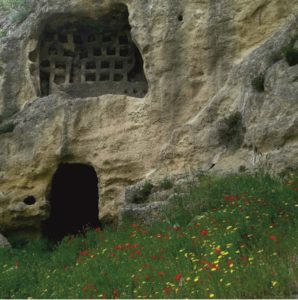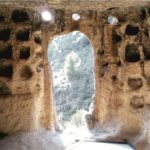Calascibetta Byzantine Village
Sicily | archaeological heritage
Calascibetta Byzantine Village
Byzantine Village, Contrada Casa del Mastro, Calascibetta, IN, Italy
How to get?
The Byzantine village of Vallone Canalotto, Site of high archaeological and natural interest, is far from Calascibetta, and it develops into a large area sloping, reaching out to the Valley of the river Morello. Due to its abundance of water, the fertility of its soils and the adaptability of its rock shelters, This place has been popular for many centuries. The still visible rocky environments, carved in the sandstone and located at different heights of the valley, witness, indeed, an extraordinary settlement continuity, which affected the site since prehistoric times until the early '900. The most important traces are, however, those relating to the Byzantine period, hence the name "Byzantine village", valuable evidence of the start rule in Sicily by the Emperor Justinian, and lasted from 535 all’827 d.C. While in ancient times, it seems that the frowning have been used by local communities mainly for funerary purposes, with the likely arrival of a monastic community from Turkey, the rock structures Canalotto seem to change the intended use and pass, then, a housing function. The site preserves, indeed, the simultaneous presence of necropolis in prehistoric times ("A cave" tombs of a period from the late Copper Age and the Iron Age), greek-Archaic period (tombe “a camera”) and Roman period and Late Antiquity (“arcosoli”, graves "form" and "columbaria", crypts with niches for urns deposition), then reworked and transformed, in Byzantine and medieval times, in a civil and religious environments. You do not know the exact time when the Byzantine communities took office in Vallone Canalotto, adapting rocky areas the basic needs, Religious and productive activities (as evidenced by the presence of two millstones, of at least one church, environments transformed into hermitages and service facilities), but it is conceivable that has come to the time of one of the two waves of migration during which the Byzantine arrived in the West: during the greek-Gothic war, promoted by the Emperor Justinian to drive the Goths from Italy, or during the iconoclasm, which took place in Constantinople after the edict issued by Emperor Leo III the Isaurian 726 d.C. condemning the cult of sacred images. Anyway, it is clear the Christian imprint left by this community, perhaps Basilian, whose rule included the monastery, ie a type of community life. Not a few, indeed, Christian symbols etched into the rock still visible on the walls of the central core of the village and the church, the latter from the plant basilical with two aisles and with a stone iconostasis. following, it seems that the village has lived an Arab stage, mainly evidenced by the presence of a qanat, that is, a system of underground tunnels for the channeling of water. Even if you do not know anything about the next story, presumably the transformation of the village on a farm, which remain evident traces of intense use and exploitation of the environments. Worthy of note is the natural context in which the archaeological site is located: immersed in a forest of eucalyptus and pine in the upstream, the downstream zone is instead characterized by the typical Mediterranean flora of the area, constituted by oaks, perastri, die, blacks poplars, white poplars, Olivastri, wild pistachios, and plants such as thyme, nepitella, mandragora, asfodelo, sarsaparilla, pungitopo.





